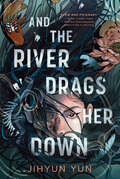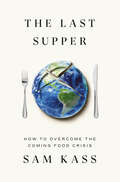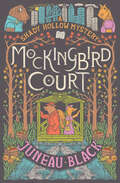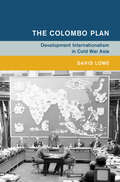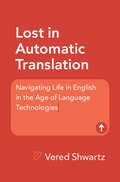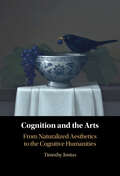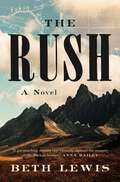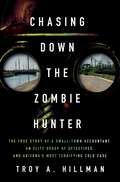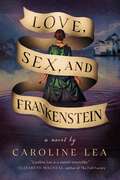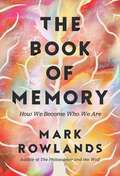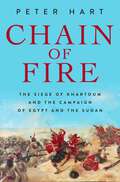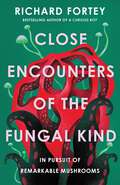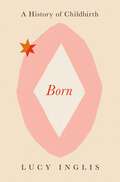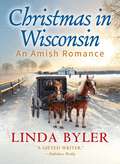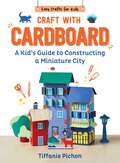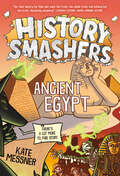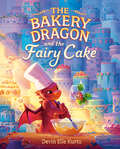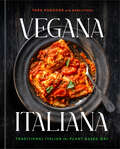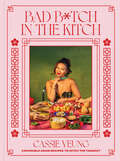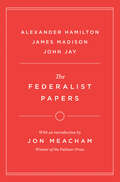- Table View
- List View
And the River Drags Her Down
by Jihyun YunShe has always known the rules: Never resurrect anything larger than the palm of her hand. But that was before her sister died. . . .&“Yun beautifully captures the haunting of family myths in this slow-burn horror. Eerie and poignant, And The River Drags Her Down will sweep readers into its relentless current.&” —Trang Thanh Tran, New York Times bestselling author of She Is a HauntingWhen her older sister is found mysteriously drowned in the river that cuts through their small coastal town, Soojin Han disregards every rule and uses her ancestral magic to bring Mirae back from the dead. At first, the sisters are overjoyed, reveling in late-night escapades and the miracle of being together again, but Mirae grows tired of hiding from the world. She becomes restless and hungry . . .Driven by an insatiable desire to finish what she started in life, to unravel the truth that crushed her family so many years ago, Mirae is out for revenge.When their town is engulfed by increasingly destructive rain and a series of harrowing, unusual deaths, Soojin is forced to reckon with the fact that perhaps the sister she brought back isn&’t the one she knew.
The Last Supper: How to Overcome the Coming Food Crisis
by Sam KassA former senior food policy advisor to President Obama breaks down how changing the way we eat can help fix the climate crisis, from rethinking daily habits to investing in new technology.&“Smart, timely, and full of purpose.&”—Michelle Obama&“A wake‑up call for the future of our planet.&”—Chef José Andrés&“An impressively compelling manifesto for food system transformation.&”—Marion NestleAs a chef in high-end restaurants, and later, in the home of then Senator Barack and Michelle Obama, Sam Kass read a lot about how eating organic and buying local was the key to remaking a food system otherwise built on climate-change-causing petroleum. But when he followed the Obamas into the White House, he realized something: While it&’s easy to identify the problems in our spoiled food system, fixing it is not as simple as getting your eggs from the farmers&’ market. Now investing in startups trying to solve the environmental and human challenges of climate change in food and agriculture.In The Last Supper, Kass shares everything he&’s learned, simplifying it all down to what he calls &“The Core Principle&”: Maximize nutrient production while minimizing environmental damage. He lays out an accessible, action-based plan to save the environment, and in turn, ourselves, based on four pillars of change:• Culture: shifting the way we think about and approach the environment as individuals is the foundation of broader change• Policy and legislation: the limited but important role of policy and how change is made on a governmental level and what we can do about it• Business: How to change the businesses that provide the food we eat as the only path to change our food system• Technology: a deep dive into the future with the new and innovative technologies researchers are using to save the environment, from CRISPR and Loam Bio to the magic of mycelium and the secret weapon that is regenerative farmingThrough anecdotes, interviews, and an astounding amount of research, The Last Supper gives us the tools we need to make a difference.
Mockingbird Court: A Shady Hollow Mystery (A Shady Hollow Mystery)
by Juneau BlackIn the latest installment in the beloved Shady Hollow series, everyone's favorite vulpine investigator Vera Vixen must contend with a cold-hearted killer—and the ghost of her own past.It's a crisp, cool autumn in Shady Hollow, and preparations are underway for the annual Harvest Festival. Creatures have flocked from far and wide to partake in the seasonal festivities, from pumpkin carving to pie tasting to soup throwing. With all these new faces around town, it&’s the perfect time for someone to slip in unnoticed.Unless that someone is Bradley Marvel, the most famous author—and most noticeable personality—in any woodland warren. It seems the wolf is on the lam. Back in the city, a body was found in his penthouse apartment at Mockingbird Court, and Marvel skipped town before the questioning could commence. Marvel claims to be innocent, and it's up to Vera and her friends to piece together what might have happened that fateful night so many miles away in the beating heart of the big city. But things get complicated when Vera learns that she also knows the victim ... and might even be implicated herself.
Venetian Vespers: A Novel
by John BanvilleA masterful, enthralling new novel from the Booker Prize winnerEverything was a puzzle, everything a trap set to mystify and hinder me. . . .1899. As the new century approaches, struggling English writer Evelyn Dolman—a hack, by his own description—marries Laura Rensselaer, daughter of an American oil tycoon. Evelyn anticipates that he and Laura will inherit a substantial fortune and lead a comfortable, settled life. But his hopes are dashed when a mysterious rift between Laura and her father, just before the patriarch&’s death, leads to her disinheritance.The unhappy newlyweds travel to Venice to celebrate the New Year at the Palazzo Dioscuri, ancestral home of the charming but treacherous Count Barbarigo. From their first moments in the mist-blanketed floating city, otherworldly occurrences begin to accumulate. Evelyn&’s already jangled nerves fray further. Where has Laura disappeared to? How to explain the increasingly sinister circumstances closing around him? Could he be losing his mind?Venetian Vespers is a haunting, atmospheric novel from one of the most sophisticated stylists of our time.
Would You Rather? Winter Edition: Warm Up with a Cool Game About Snow, Sports, Food, and Holidays (Would You Rather?)
by Lindsey DalyHilarious questions about the joys of winter for kids who love fun, laughs, and a challenge, from the bestselling author of Would You Rather? Summer Edition.Cozy up to winter fun with this laugh-out-loud Would You Rather? book—the perfect companion for all your favorite winter activities. Whether you&’re building a snowman, skiing down a snow-covered slope, eating comfort food, or celebrating the solstice, this winter book for kids and their families will keep you warm on chilly winter days.Would You Rather? Winter Edition features:Thought-provoking scenarios that delight and challenge kids ages 8–12 to think creatively and speak persuasively.160+ &“Would You Rather?&” questions about cool sports, snowy weather, holiday celebrations, school vacations, and so much more.Awesome entertainment for holiday get-togethers, hangouts with friends, and snow days.Tech-free fun for winter days spent indoors.A competitive game for kids and families; who&’s the smartest of them all?Would You Rather? Winter Edition will keep you entertained and laughing as you head out to ski or skate, celebrate Christmas or New Year&’s Eve, drink hot chocolate or hot cider, or simply relax after a fun day in the snow.
The Colombo Plan: Development Internationalism in Cold War Asia (Global and International History)
by David LoweConceived in 1950, the Colombo Plan for Co-operative Development in South and Southeast Asia was a unique experiment in foreign relations. Meeting annually across what we now know as the 'Indo-Pacific', talented administrators facilitated foreign aid provision, and promoted development fuelled state-making, internationalism and experimental regionalism across postwar Asia. David Lowe argues that this new setting and dynamic international cast created an unusually productive diplomatic environment of development internationalism. The Colombo Plan did not escape power politics or Cold War divisions. However, it did run according to its own rhythm, and, unlike other experiments, it endured, continuing today in much reduced form.
Lost in Automatic Translation: Navigating Life in English in the Age of Language Technologies
by Vered ShwartzThe last decade has seen an exponential increase in the development and adoption of language technologies, from personal assistants such as Siri and Alexa, through automatic translation, to chatbots like ChatGPT. Yet questions remain about what we stand to lose or gain when we rely on them in our everyday lives. As a non-native English speaker living in an English-speaking country, Vered Shwartz has experienced both amusing and frustrating moments using language technologies: from relying on inaccurate automatic translation, to failing to activate personal assistants with her foreign accent. English is the world's foremost go-to language for communication, and mastering it past the point of literal translation requires acquiring not only vocabulary and grammar rules, but also figurative language, cultural references, and nonverbal communication. Will language technologies aid us in the quest to master foreign languages and better understand one another, or will they make language learning obsolete?
Cognition and the Arts: From Naturalized Aesthetics to the Cognitive Humanities
by Timothy JustusHow does the mind lend itself to artistic creation and appreciation? How should we study minds and arts in ways that transform our understanding of both? This book examines the concepts of art and cognition from the complementary perspectives of philosophy, the empirical sciences, and the humanities. Central chapters combine examples of visual art, music, literature, and film with the properties of cognition that they illuminate, including 4E cognition, predictive processing, and theories of affect and emotion. These aspects of cognition are undergoing theoretical shifts that complicate established understandings of the mind and its encounter with the arts. As the book takes stock of recent developments in aesthetics that have incorporated empirical findings (Naturalized Aesthetics), it also envisions a new generation of cognitive science with robust ties to history and literature (the Cognitive Humanities). In this way, Cognition and the Arts can be seen as a model of interdisciplinary scholarship.
The Rush: A Novel
by Beth LewisIn a lawless land stricken with gold fever, the struggle for survival and fortune takes a turn towards murder in this gripping western crime novel from the author of The Wolf Road.Gold fever has taken him. I believe he means to kill me... Canada, 1898. The Gold Rush is on in the frozen wilderness of the Yukon. Fortunes are made as quickly as they're lost, and Dawson City has become a lawless settlement. In its midst, three women are trying to find their place on the edge of civilization. Journalist Kate, along with her dog Yukon, has travelled hundreds of miles after receiving a letter from her sister warning that her husband means to kill her. Martha's hotel and livelihood are under threat from the local strongman, who is set on buying up the town. And down by the river, where gold shimmers from between the rocks, Ellen feels her future slip away as her husband fails to find the fortune they risked so much to seek. When a woman is found murdered, Kate, Martha and Ellen find their lives, fates and fortunes intertwined. But to unmask her killer, they must navigate a desperate land run by dangerous men who will do anything for a glimpse of gold...
Chasing Down the Zombie Hunter: The True Story of a Small-Town Accountant, an Elite Group of Detectives, and Arizona's Most Terrifying Cold Case
by Troy A. HillmanThe stranger-than-fiction story of the terrifying "Zombie Hunter" whose brutal crimes nearly went unsolved until an unconventional detective and his team solved the mystery of a real-life monster hiding in plain sight.Bryan Miller aka The Zombie Hunter, was a cavalier character juxtaposed as a single parent of a teenage daughter. He sported Steampunk attire, wielded a gatling gun at Comic Con conventions, and rode around in a custom fitted police looking car with green lights on the top and the &“The Zombie Hunter '' detailed on the side. While his outward appearance and interests were a bit eccentric, little did people know, he was a real-life killer and predator that had been terrorizing the Phoenix area since 1992. Chasing Down the Zombie Hunter is the extraordinary, detailed inside story of how a small-town ex-CPA, Detective Troy Hillman, and an elite team of detectives—hounded by the press, a frustrated and frightened public, and their own doubts and exhaustion—solved a double murder that had haunted the Valley of the Sun for more than twenty years. The initial details were already chilling—the brutal murder of two women, found headless, who were assaulted while riding their bikes along a well-known canal bike path—but with his inside-perspective, Hillman reveals how the initial headlines only scratch the surface. Besides giving the families of Angela Brosso and Melanie Bernas closure and justice, Detective Hillman's groundbreaking methods and his familial DNA case set the precedent for cold cases like The Golden State Killer. Chasing Down the Zombie Hunter reveals how evidence that was already in possession of the police turned out to be the key to catching the killer—once they new how to look at it. From frustrations and heartbreak to bizarre twists and incredible breakthroughs, Detective Hillman takes true crime devotees through every facet of how, against all odds, the suspect was found and arrested. Chasing Down the Zombie Hunter is a testament to the fact that no matter how old the case, there is always hope for justice...if you know where to look.
Love, Sex, and Frankenstein: A Novel
by Caroline LeaAn evocative, haunting retelling of the summer that should have broken Mary Shelley, but instead inspired her to write her masterpiece.Villa Diodati, Lake Geneva, 1816: the dark summer that birthed a monster. Eighteen-year-old Mary Shelley has fled London with her lover, Percy Shelley, and her sister, Claire. Tormented by Shelley&’s betrayals, haunted by the loss of their baby, and suspicious of her sister&’s intentions, Mary seeks a refuge. But Lord Byron&’s villa, lying under ominous, ash-shrouded skies, feels more like a trap. When Byron suggests each guest write a supernatural tale, Mary is as drawn to the challenge as she is, unexpectedly, to Byron himself. And so an idea begins to form in her mind . . . It spills out of her in thick, black ink. A thing given life by her imagination. Day and night, it possesses her. Her heart, her desires. But is she in control, or is it? In this hauntingly evocative feminist retelling, Caroline Lea delves into the female rage, creative madness and steamy scandal that bore the world's most famous work of gothic fiction.
The Complete Folk Herbal: An Illustrated Guide to Natural Remedies and Everyday Healing
by Rebecca BeyerA definitive, beautifully illustrated guide to the folklore, history, and everyday utility of nearly 100 plants, trees, and shrubs.Reconnect with the wisdom of the land through this comprehensive guide from forager and ethnobotanist Rebecca Beyer. Richly illustrated and deeply researched, The Complete Folk Herbal celebrates nearly 100 plants, each one steeped in story, tradition, and healing power. Inside you&’ll find: - Detailed plant profiles covering origins, physical appearance, folklore, traditional uses, and modern applications. - Everyday remedies for headaches, burns, fatigue, insomnia, menstrual pain, and dozens of other common complaints. - Practical recipes for teas, tinctures, decoctions, salves, balms, and more. - Sustainable foraging practices that emphasize ethical harvesting and mindful stewardship of the earth&’s resources. Accessible yet encyclopedic, The Complete Folk Herbal is both a reference and an invitation to deepen your relationship with plants, honor the traditions of folk healing, and embark on a lifelong journey of herbal wisdom.
The Book of Memory: How We Become Who We Are
by Mark RowlandsA brilliant journey through the nature of memory, helping us understand how what is lost—and what is remembered—shapes who we are.In this revelatory and intimate exploration of the way memory works, Mark Rowalds, author of The Philosopher and the Wolf, reveals how memories aren&’t fixed. They soften and consolidate—and are distorted—each time we revisit them, even those memories most deeply engrained. The way we call on memory is closer to a "negotiation with the past." From episodic memories like "shining islands in dark waters" and forgotten "Rilkean" memories that underpin our personalities and essential style to the memories we might hold that have been authored by others close to us, The Book of Memory draws on philosophical argument, a range of writers and thinkers, the latest neurological research, and psychology experiments to chart how memories are made, lost and remembered, with important consequences for how we understand ourselves.
Chain of Fire: The Siege of Khartoum and the Campaign of Egypt and the Sudan
by Peter HartThe dramatic story of the siege of Khartoum and Britain&’s extraordinarily violent 1882 campaign in Egypt and Sudan.In the 1880s, British control over northeastern Africa was a political minefield that Prime Minister William Gladstone wished to avoid—until his emissary Charles Gordon was besieged in Khartoum, and the city became the focal point for war. It was the height of European colonialism. Injustices were administered, bloody battles fought, and civilians were often caught in the crossfire. Among the famed British officers involved were figures who would later adopt starring roles in World War I, such as Egyptian Army officer Captain Herbert Kitchener. By turns shocking and dynamic, Chain of Fire examines the terrible desert wars using the testimonies of the men who fought there.
Close Encounters of the Fungal Kind: In Pursuit of Remarkable Mushrooms
by Richard ForteyA magical, deeply informed book that takes us from familiar places into the strange world of of fungi.The secret world of fungi is another kingdom. They do things differently there. Diverse beyond our wildest imaginations, fungi don&’t obey rules. They pop up unbidden and often dressed in curious reds and greens. They do not seem of this world, yet fungi underpin all the life around us: the "wood wide web" links the trees by a subterranean telegraph; fungi eat the fallen trunks and leaves to recycle the nutrients that keep the wood alive; they feed a host of beetles and flies, which in turn feed birds and bats. Fungi produce the most expensive foods in the world but also offer the prospect of cheap protein for all; they cure disease, and they both cause disease and kill; they are the specialists to surpass all others; their diversity thrills and bewilders. Professor Richard Fortey has been a devoted field mycologist all his life. He has rejoiced in the exuberant variety and profusion of mushrooms since reading as a boy of nuns driven mad by ergot (a fungus). Drawing on decades of experience, Fortey starts with the perfect "fungus day"—eating ceps in Piedmont. He introduces brown rotters, earthstars, and death caps; fungal annuals and perennials, dung lovers and parasites, even fungi that move through the trees like mycelial monkeys. We learn that the giant puffball produces more spores than there are known stars in the universe and fetid stinkhorns begin looking like arrivals from the planet Tharg. He tells of the fungus that turns flies into zombies, the ones that clean up metallic waste, and the delicious subterranean fungi truffe de Perigord, the delight of gourmets. Amongst these and many other "close encounters," Fortney attempts to answer the questions: what exactly are fungi? Why did their means of reproduction escape discovery for so long? What role do they play in the development of life? The vast kingdom of fungi is more diverse and species rich than plants or animals. By exploring their glorious profusion, Close Encounters of the Fungal Kind reveals so much about their world—and ours.
Born: A History of Childbirth
by Lucy InglisA groundbreaking history of childbirth filled with medical, political, and social triumphs, Born is the story of how we give birth set against the female struggle to govern their ability to reproduce.Born moves around over time and large geographical, social, and cultural distances, but returns continually to a series of themes: the experience of pregnancy, the act of childbirth, and latterly, the fight for reproductive autonomy. Whatever their ultimate outcomes, pregnancy and the act of childbirth are at once an individual and communal event. No two births are the same, yet the history of childbirth informs us about so much more than this intimate moment in the lives of a woman and her offspring. The act of childbirth informs us as unique individuals, yet at the same moment makes us part of something much greater than ourselves. This book is the sum of many stories that combine war, art, science, and politics with the fundamental act of human existence. It is not a book about parenting or motherhood beyond the moment of delivery and the short time afterward. Instead, this is a story of the evolving role pregnancy and childbirth have played in societies through history, of the mysticism, the practicalities, and the power struggles that have shaped nations, yet also, individual identities. Our narrative starts out in prehistory and ends now, with the reversal of Roe v. Wade, taking in mother-and-child bone fragments of the Ice Age, the cries from the medieval birthing chair, and the calls to rally of our modern age. This is how we are Born.
Christmas in Wisconsin: An Amish Romance
by Linda BylerWrap yourself up in this cozy Amish romance as you follow three intertwining love stories at Christmastime.Lydia Beiler loves teaching school in her Amish community in Wisconsin. As a single woman in her fifties, the scent of chalk dust and the feel of a red Bic pen between her fingers is her calling, and she lives it to the full extent. But teaching isn't without its struggles—namely Jesse Stoltzfus, a sixth grade boy who pushes Lydia's patience to the limits. It doesn't matter how many times she makes him stay in from recess; he seems determined to argue everything and distract the other students with his toe tapping and incessant teasing.When a late autumn snowstorm leaves Lydia trapped alone at the schoolhouse without heat, it is none other than Jesse who comes to her rescue. He helps bring her safely to his house, where Lydia is embraced by the Stoltzfus family. The joy and warmth of their home awakens a sort of longing in Lydia's heart, a loneliness she didn't realize was there. Is it too late for her to find love?Meanwhile, as Christmas approaches, Jesse's older sisters are wrapped up in their own romantic interests. When Becca begins &“unofficially&” dating Ray, Laura struggles to accept the fact that her younger sister is moving faster than she is. Will the handsome, older guy she met at the last wedding ever ask her out?
Craft with Cardboard: A Kid's Guide to Constructing a Miniature City (Easy Crafts for Kids)
by Tiffanie PichonPut yourself in the shoes of a real architect and create your very own city out of cardboard! In this guided collection, young crafters and artists will find step-by-step instructions and full-color photographs that will aid them in creating a whole city (people and vehicles included!) out of cardboard. Author and artist Tiffanie Pichon opens with encouraging words that will inspire crafters to pay closer attention to their surroundings as they move through their city or town. The architecture—from roof to window—the sidewalks, parks, and even the jobs people are doing while they walk or drive through a city may inspire their creations as they construct their very own city out of recycled materials, like cardboard. The projects featured throughout this fully illustrated book will come together to create a neighborhood, but may also inspire future projects such as DIY rural towns and farms. Types of creations include houses and stores, towers and skyscrapers, factories, people and animals, vehicles, mountains, trees, benches, and more—all requiring the most basic supplies (tape or glue, scissors, paints or markers, rulers, colored paper, egg cartons, etc.) and whatever recycled or natural materials the crafter wants to use!
History Smashers: Ancient Egypt (History Smashers)
by Kate MessnerMyths! Lies! Secret mummy curses? Grab your head lamp, the award-winning History Smashers are headed to Ancient Egypt to dig up the truth about this incredible early civilization—and the many myths that will be buried once and for all.In 1922, explorers opened King Tut's tomb and a nasty hex was placed on everyone present. RIGHT? Not so much. Okay, but aliens did soar in on a space craft and build the Pyramids, right? WRONG!The discovery of King Tutankhamun's tomb taught historians a lot about ancient Egyptian culture. But no one incurred the wrath of a mummy. And this early civilization had the money, power, and smarts to build the Pyramids--along with a host of other impressive structures! Join the History Smashers Ready to bust new myths? Check out more titles in the History Smashers series:History Smashers: The MayflowerHistory Smashers: The TitanicHistory Smashers: Pearl HarborHistory Smashers: Plagues and Pandemics
The Bakery Dragon and the Fairy Cake (The Bakery Dragon)
by Devin Elle KurtzRunning a bakery is no cakewalk for a tiny dragon with a big sweet tooth! Tummy rumbles turn to belly laughs in this feel-good picture book from the bestselling author and illustrator of The Bakery Dragon.Batter up!Ember is in charge while the baker takes a trip and he's excited to show what he can do! When an opinionated fairy princess swoops in demanding a cake, he eagerly agrees. So what if he's only baked bread before? How hard can it be?The sugar hits the fan when Ember's first attempt is a complete disaster. He tries again and again, but the royal customer is not happy. Everyone told Ember he was such a good baker, so why can't he get this right? If he doesn't figure it out soon, the only thing on the menu will be humble pie.Magic shimmers on every page of this whimsical story about how to bake a cake, make new friends and learn from your mistakes.
Trust God, Love People: Stories of My Openhanded Faith
by Jenny MarrsIn this inspirational memoir, the beloved co-host of HGTV&’s Fixer to Fabulous asks: When you look back at the stories of your life, where do you see the markers of God&’s faithfulness?&“Reading this warm, charming story feels like sitting down with a close friend and sharing stories of faith and family.&”—Kimberly Schlapman, founding member of the Grammy Award–winning band Little Big TownWhen Jenny Marrs looks at all the ways God has shown up in her life, she&’s left with immense gratitude for a God who is always, ever faithful. Even as she has trusted that God was leading her, the big picture of her journey was often murky and unknown.In Trust God, Love People, Jenny opens wide the doors to her life and her family&’s home to share stories of how little steps of faith have added up to an unexpected and abundant life. We ride shotgun next to her as she moves to Bentonville, Arkansas, where she knows almost no one, and watch her slowly put down roots. The sweet stories of how she met Dave and of their early days of marriage and first homes together are here, as are the candid pain and hope of their time spent waiting to start a family before joyfully welcoming their twin boys. Jenny shares intimate glimpses into their years-long fight to adopt their daughter Sylvie from the Democratic Republic of the Congo, as well as behind-the-scenes details about how their work to restore old homes became Fixer to Fabulous.Through it all, Jenny learns that God is trustworthy even in the moments when she feels fearful, worn out, or dejected. Trust God, Love People is a guiding principle in Jenny&’s life, and serves as a reminder that steadfast trust in our faithful, loving God allows us to love others well. As we, like Jenny, learn to take our next step in faith and love the people around us, we can walk confidently into adventures beyond our wildest expectations.
Vegana Italiana: Traditional Italian the Plant-Based Way; A Vegan Cookbook
by Tara PunzoneDiscover the delicious flavors of plant-based Italian cooking with more than 100 vegan recipes inspired by classic Italian dishes, from the owner and chef of Pura Vita &“Part love letter to Italy, part encyclopedia of plant-based technique, Vegana Italiana is a joyous celebration of food, family, and heart. I want to make everything in this book!&”—Joanne Molinaro, New York Times bestselling author of The Korean VeganEver wish you could whip up vegan versions of fresh cheese ravioli or meatballs? As the owner and chef behind the first 100% plant-based Italian restaurant in the United States, Tara Punzone knows how to transform classic Italian staples into delicious vegan dishes without sacrificing any flavor. Growing up in a big Italian family in New York, food was always at the heart of Punzone's community and gatherings. Her debut cookbook, Vegana Italiana, offers more than 100 vegan Italian recipes inspired by her family&’s meals and fan-favorites from her Los Angeles-based restaurant Pura Vita. When Punzone decided to go vegan when she was twelve years old, she learned how to follow a vegan lifestyle without compromising her traditions, heritage, or love of bold flavors, and this cookbook shares her tips to help you do the same, while also embracing new techniques and flavors along the way. She also shares her personal stories and memories from growing up in New York and moving to California as well as the culinary inspiration she received from her family. With tips for stocking your pantry and strategies to replicate Italian essentials like mozzarella and ricotta cheese, Vegana Italiana includes delicious recipes like:• The Basics: Macadamia Parmigiano, Alfredo Sauce, and Roasted Garlic Aioli• Antipasti: Bruschetta, Garlic Parmigiano Potato Wedges, and Strawberry Almond Ricotta Crostini• Insalata e Verdure: Caprese, Peppas, and Stuffed Artichokes• Soups and Stews: Minestrone, Sicilian Red Lentil, and Roasted Garlic Creamy Tomato Soup• Pasta: Ravioli Pomodoro, Pesto Calabrese, and Cacio e Pepe• Secondi: Eggplant Parmigiana, Meatball Parmigiano Hero, and Heartbeet Risotto• Dolci: Tiramisu, Panna Cotta, and Lemon Mint GranitaComplete with gorgeous full-color photography taken at Pura Vita, Vegana Italiana is your ultimate guide to vegan Italian cooking.
Bad B*tch in the Kitch: Craveable Asian Recipes to Ditch the Takeout: A Cookbook
by Cassie YeungAdd some razzle dazzle to your home cooking with 80 recipes for your favorite Asian takeout dishes from culinary influencer Cassie YeungCassie Yeung likes to think of herself as a chef for the people—no professional culinary training here, just a girl who really loves to cook (and eat, obvi). She believes that the #1 rule in the kitchen is to have fun, let loose, and cook the way you want to. For Cassie, that means yelling &“behind!&” in her own kitchen, softening butter against her skin, and showing off her baddie nails as she pleats dumplings like a boss.In Bad B*tch in the Kitch, Cassie serves up the food she loves most: the Asian dishes she grew up eating and now craves on the regular. So many people know and love Chinese, Thai, Vietnamese, and Singaporean cuisine, but they don&’t always know how easy it can be to recreate their favorite dishes at home. Cassie shares some of her go-to dishes, dialed in for home cooks, in chapters such as:First Bite Besties: Crab Rangoons, Siu Mai (Steamed Pork and Prawn Dumplings), Spam MusubiNoodz: Scallion Oil Noodles, Pad See Ew, Spicy Miso Instant RamenSkip the Takeout: Sweet & Sour Pork, 30 Minute Beef + Broccoli, Chicken Katsu CurryNot Too Sweet: Lazy Girl Mango Sticky Rice, Brown Butter Matcha Cheesecake, Vietnamese Coffee TiramisuWhole Lotta Basics: Hand Pulled Noodles, Ginger Scallion Sauce, Peanut Dipping SauceNot only can you save money by skipping takeout, but everything tastes better homemade, too. With Cassie's delicious and approachable recipes, you can confidently whip up classic noodles, stir fries, and soups whenever the craving strikes.
The Federalist Papers
by Alexander Hamilton James Madison John Jay#1 New York Times bestselling author Jon Meacham presents the brilliant and stirring essays in defense of the Constitution—written by Alexander Hamilton, John Jay, and James Madison—that made the American republic.In September 1787, after a long summer of intense deliberation and compromise, the Federal Convention released a proposed Constitution of the United States—and immediately ignited a firestorm. Public debate was passionate and fierce. Supporters, the Federalists, believed the Constitution would save the floundering former colonies from the confusion and anarchy of the current, weak government. Detractors held that adopting the Constitution would mean nothing less than the end of American liberty. The Federalists—among them George Washington and Benjamin Franklin—knew that the stakes could not be higher: the ideals of the Declaration of Independence, and America&’s very existence as an independent nation, depended on the protection of the Constitution. And so on Saturday, October 27, 1787, Alexander Hamilton came to its defense, publishing the first column of what would come to be known as The Federalist Papers. Written by Hamilton, James Madison, and John Jay from October 1787 to August 1788—a span of 294 days that ranks among the most consequential periods in politics—The Federalist Papers are part history, part political science, and part theology. Introduced here by bestselling American historian and biographer Jon Meacham, they offer unparalleled insight into the workings of the democratic process and the values underpinning the American project—then as now.
Yours For The Season: A Novel
by Emily StoneCould a fake relationship with your ex over Christmas in Scotland be the perfect opportunity for revenge—or a second chance at love? One woman is about to find out in this charming holiday romance from the author of Always, in December and A Winter Wish.Melanie hasn&’t had a good year. Her work life isn&’t what she dreamed it would be, her best friend has moved to the other side of the world, and Finn, the man she was sure was the love of her life, dumped her. In front of everyone. At his sister&’s engagement party.So when Finn shows up at Mel&’s doorstep two weeks before Christmas, asking if she&’ll help him, her first instinct is to slam the door in his face—or punch him. But he has a proposal for her: Spend the week of Christmas with him and his family in a vacation cottage in the Scottish Highlands. His mother is obsessed with the idea of a perfect Christmas—and to make this dream come true Finn told his mother that he and Mel are dating again. All Mel has to do is come with him and pretend they&’re back together.Mel may hate Finn, but she loves his mom. So she agrees—on one condition. At the end of the week, Finn will allow Mel to publicly dump him so that she can get her dignity back and he can experience the same humiliation she felt. It&’s only a week. Mel can pretend to still be in love with Finn for one week, surely. Except as the festivities bring her closer than ever to Finn and his family, Mel starts to lose track of which feelings are fake and which are for real.
